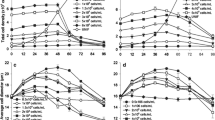Abstract
The retroviral titer obtained from the pMFG/ψCRIP producer cell line is determined by a dynamic interplay of vector production and deactivation rates. Both these rates are influenced by temperature. It was determined that; (i) the retroviral half-lives are strongly influenced by temperature and the temperature dependency can be described by the Arrhenius equation with an activation energy of 39 kcal/gmol; (ii) the actual retroviral vector productivity per cell is highest at 37 °C with retroviral production rate of 24.4(±7.0; ± standard deviation) colony forming unit (CFU)/cell/day; (iii) the dynamic interplay of these two factors produces an optimal temperature of 34 °C for pMFG/ψCRIP cells under the culture conditions used; and (iv) the cellular growth rate is highest at 37 °C at 26.8 hr doubling time. Taken together, these parameters can be used to optimize a two-step retroviral production protocol, where the cells are first grown under optimal growth conditions (37 °C) and second, the virus is produced at 34 °C to yield the highest titer. These results have significant implications for optimal retroviral production protocols.
Similar content being viewed by others
Author information
Authors and Affiliations
Additional information
Received: 18 November 1997
Rights and permissions
About this article
Cite this article
Lee, G., Choi, J., Jun, S. et al. Temperature significantly affects retroviral vector production and deactivation rates, and thereby determines retroviral titers. Bioprocess Engineering 19, 343–349 (1998). https://doi.org/10.1007/s004490050530
Issue Date:
DOI: https://doi.org/10.1007/s004490050530




